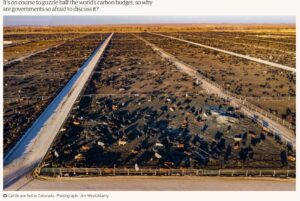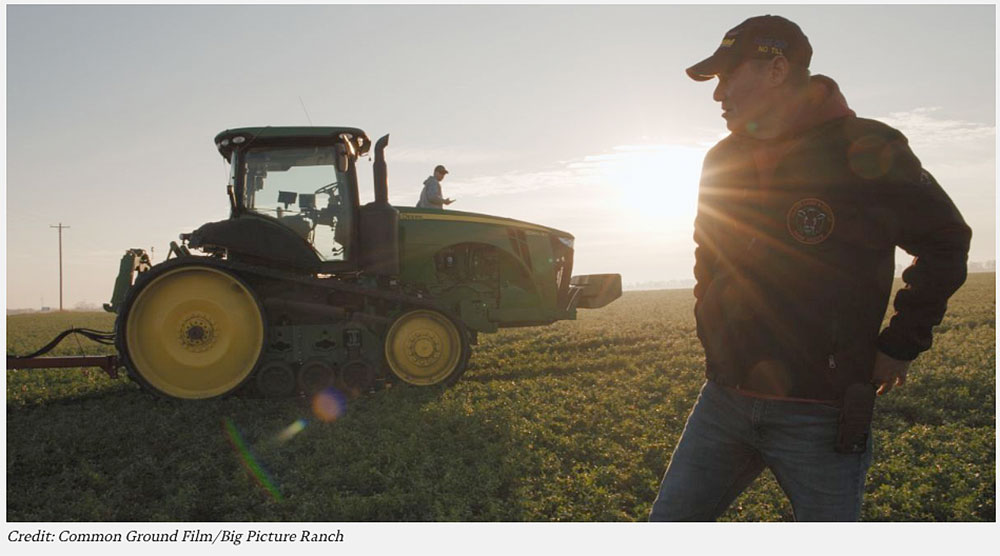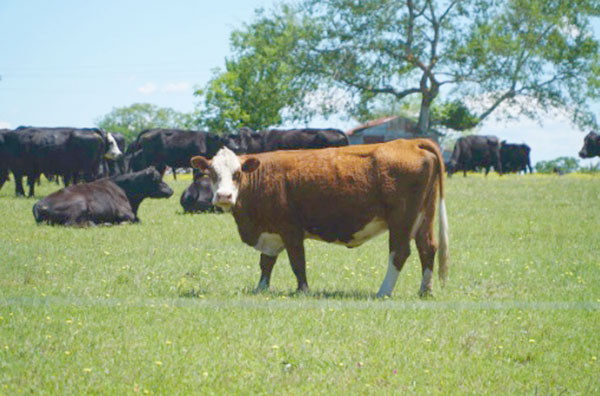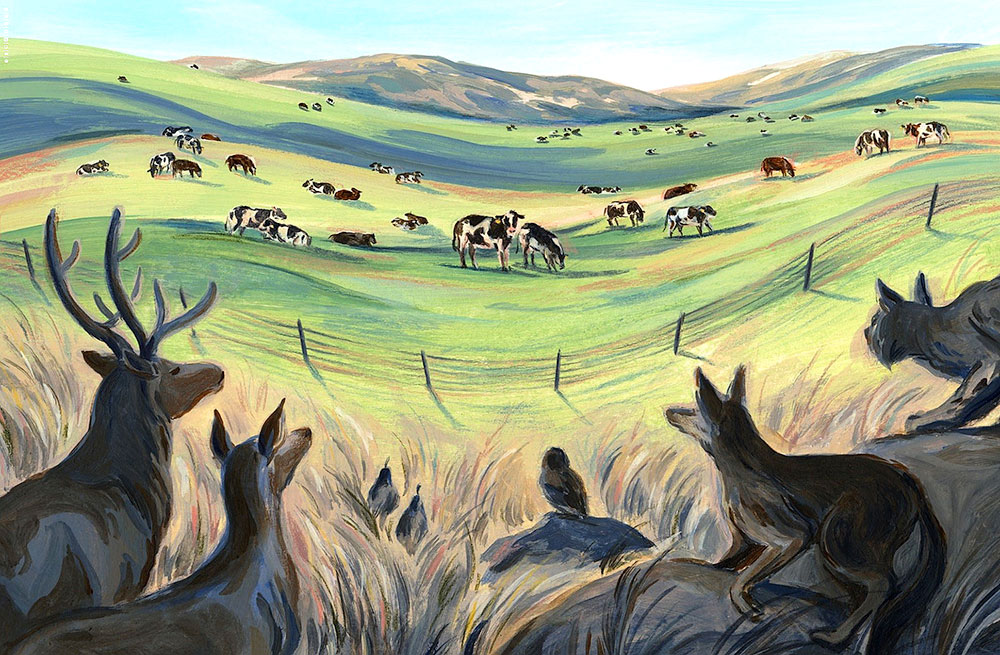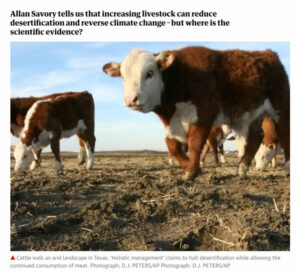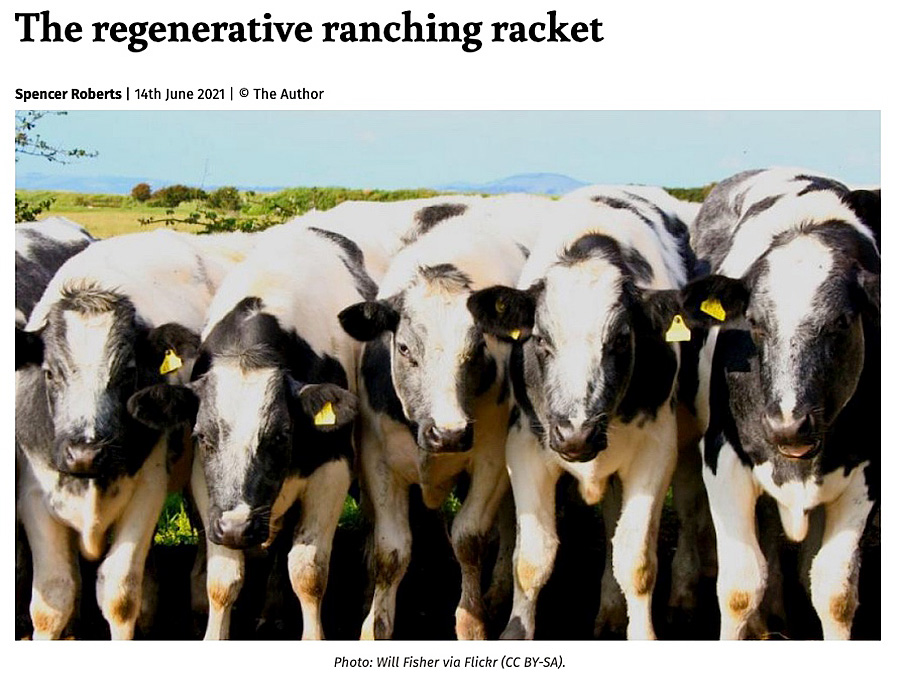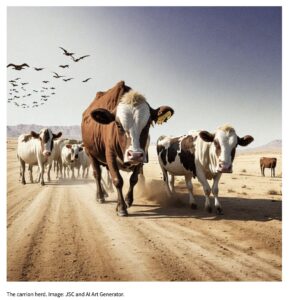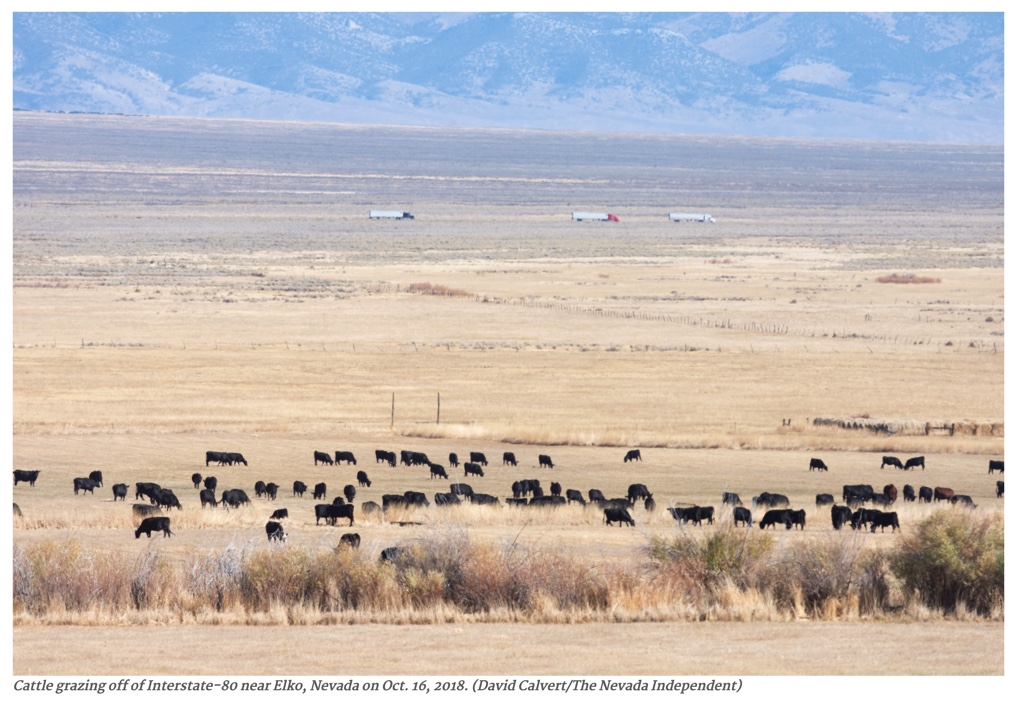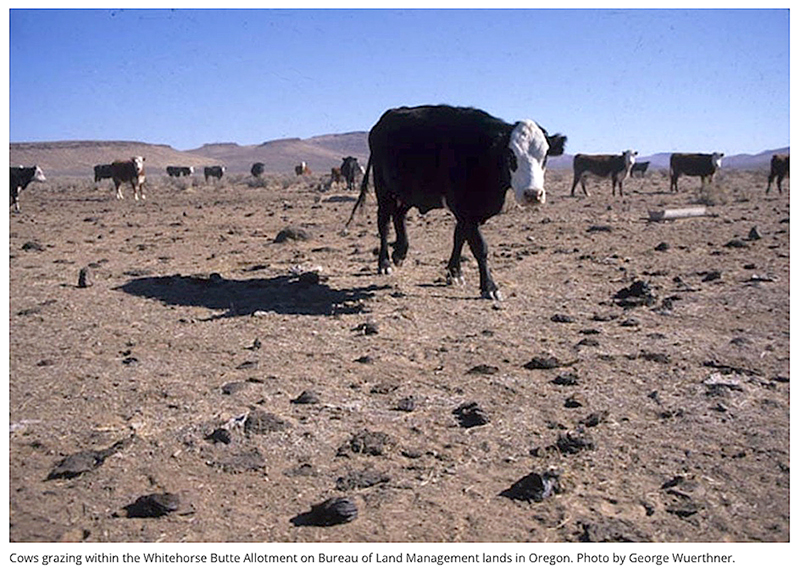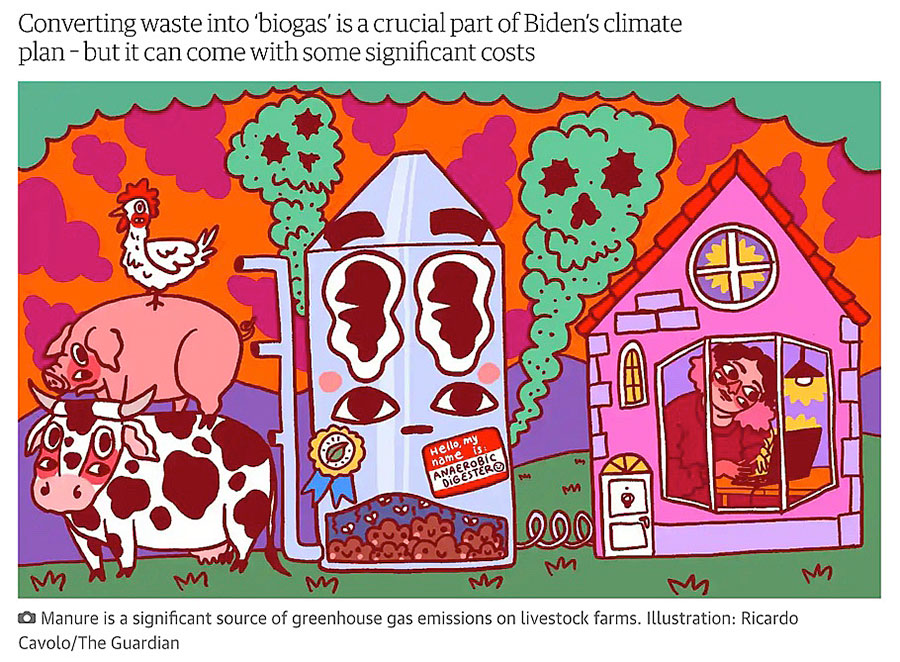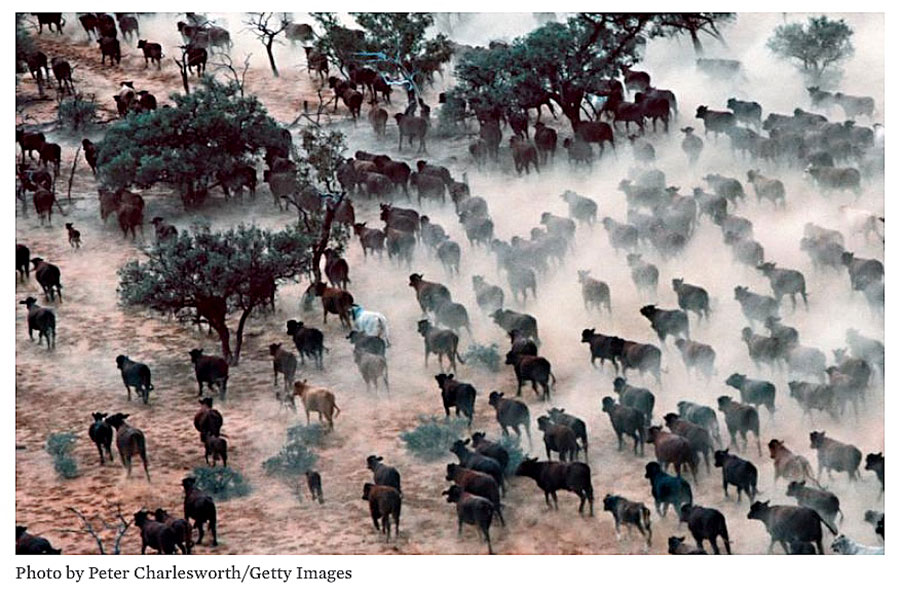So-called “regenerative” cattle ranching is just more bull.
WATCH 7 MIN. VIDEO, above, for a brief overview:
“Is grazing animals good for the environment?”
“Regenerative grazing…”
“Intensive Rotational Grazing…”
“Holistic management…”
“Free-range, grass-fed, organic…”
LOTS MORE cattle industry public relations manure.
LOTS MORE literal cow manure.
LOTS MORE land.
LOTS MORE climate-heating methane gas.
The trendy terms above, variations on a theme, all involve grazing dairy and beef cows on more land, and moving them around more often. Proponents claim this mimics the effect of wild ungulate grazing — while ignoring the reality of the massive soil compaction, extensive damage to vegetation, and mountains (or pastures) of manure pollution and waterways contamination that characterize cattle grazing on wild lands.
So-called “regenerative” grazing is the “clean coal” of the cattle industry. The public relations campaign to sell minor improvements as the antidote to the massive ecological damage — soil erosion, desiccation and compaction; massive water consumption of cattle (in California, eg., more than all residential water use) plus millions of pounds of manure, and last and not least of all, methane, 20-80x more heat-trapping than CO2. All these impacts are inherent in raising domesticated cows to feed millions of modern homo sapiens their meat and milk-laden diet.
The real and simple ecological fix — encouraging people to swap out dairy and beef for more plant-based foods — reduces greenhouse gas emissions and other ecological impacts substantially more than any clever new livestock “management” techniques. This includes attempting to have imported European hyper-bred bovines mimic grazing habits of wild native-to-America animals like bison.
Moving the same millions of today’s cattle around more frequently (to minimize vegetation and soil damage) would require enormously more amounts of land, and more water in the increasingly drought-stricken west, and more food (vegetation and/or grain) than feedlot cows. Raising cattle for people to eat (and drink their milk) is a staggeringly inefficient and ecologically destructive practice in the 21st century. Regardless of how “historic” or “traditional” the practice may be. It’s also not especially healthy for today’s relatively inactive and obese modern people.
Claims that “grass-fed” cows do less ecological damage than the millions of cows in industrial feedlots simply ignore the methane emissions of cows which are a major GHG (greenhouse gas) driver of the global heating.
DEBUNKING COW INDUSTRY FILMS
Sky-Jack Podcast #26 – May 20th, 2025
“Kiss The Ground” hides cows in the shade of the umbrella of regenerative “agriculture.”
The Cattle Empire has been striking back against all the recent science revealing their industry’s massive amounts of dairy & beef cow manure and methane pollution of land, waterways, ocean and the atmosphere.
One prominent example of the cow business monkey business is within the otherwise worthwhile documentary film, “Kiss The Ground” (and its companion film, “Common Ground”). Narrated by activist Woody Harrelson, its deception includes bundling cows in with plants and calling it all, together, “agriculture.”
And then focusing on carbon emissions while entirely ignoring the massive methane (CH4) output of millions of cows. And the greater ecological damage done by so-called “small” “free-range” “grass-fed” cow farms.
We dig into lots more of this public relations dirt, rich with manure, explaining how the cattle industry is doing what the fossil fuel industry did for decades (and does still), muddying the discourse to keep their polluting business up and running.
CLICK TO WATCH May 20th Sky-Jack
Grazed & Confused – Food Climate Research Network REPORT
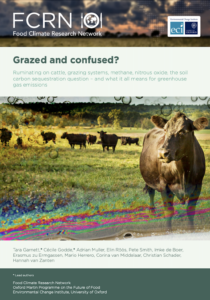 In our modern era of social media information — and misinformation — overload, prestigious institutional information from respected academic and university sources is more valuable than ever.
In our modern era of social media information — and misinformation — overload, prestigious institutional information from respected academic and university sources is more valuable than ever.
Which is why Communist China discredited and jailed academics, educators, universities, artists, and of course activists. (And why two Trump Administrations target these independent institutions and voices here in the U.S., to erode public trust in institutions, so an authoritarian government becomes the last remaining source of centralized information.)
Before that happens, and while the Trumps and Elon Musks and Joe Rogans ignore and dismiss precious, hard-won institutionalized knowledge — including established atmospheric and climate science from NASA, the EPA and the world’s climate scientists who still have an independent voice, read the 2017 Grazed and Confused report. Authored by more than a dozen, prestigious European academic sources including Oxford, Aberdeen, Cambridge, and Wageningen Universities.
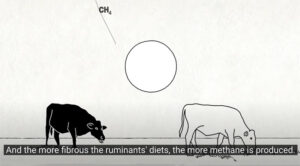
“Grazed & Confused” Report EXCERPT:
Ruminants emit methane: they generate about a third of all global anthropogenic methane emissions. Methane emissions tend to be higher, per unit of food output, in grazing than in mixed or landless systems.
Methane is a powerful greenhouse gas. But while it has a stronger immediate warming effect than CO2, it has a shorter atmospheric life span. The effect of a given pulse of methane is temporary, unless replaced by another pulse. In contrast CO2’s warming effects are weak, but since they are de facto permanent, the next pulse of CO2 emitted adds to the warming effects of what was emitted before. So, because of their differing lifespans, a constant emission of CH4 is therefore equivalent to one-off release of CO2.
Nevertheless, while methane may have a short atmospheric lifetime, its effects are not ephemeral provided the source of the methane continues to exist. For as long as livestock continue to be farmed, methane continues to exert a warming effect upon the climate. As such the argument that since methane’s impacts are temporary, they do not matter, is wrong. Its effects will in practice be permanent, unless ruminant production is halted. Methane emissions also increase the risk of us ‘overshooting’ the 1.5°C/2°C target, potentially tipping us into unknown climatic territory, with possibly devastating effects on agriculture, wildlife’s ability to adapt, heat stress in humans and animals, and more.
READ Grazed & Confused REPORT: https://treespiritproject.com/wp-content/uploads/2024/12/FCRN-Food-Climate-Research-Network-Oxford-et-al-Grazed-and-Confused-2017-REPORT-Animal-Ag-GHGs.pdf
WATCH “Grazed & Confused” VIDEO:
How much can grazing livestock help to mitigate climate change?
The big subject (climate) Cop27 wouldn’t touch: livestock
 Livestock farming is on course to guzzle half the world’s carbon budget, so why won’t governments discuss it?
Livestock farming is on course to guzzle half the world’s carbon budget, so why won’t governments discuss it?
by George Monbiot, November 9, 2021
Renewable energies – specifically solar and wind — are already our best options economically, not just ecologically. And of course economics are tied to the environment. How many hundreds of billions (trillions?) of dollars will more heat waves, droughts, wildfire, hurricanes, food shortages, and other disasters on our horizon, cost humanity?
EXCERPT:
Like the fossil fuel industry, livestock corporations have been ploughing money into public persuasion, using tactics first developed by tobacco companies. Some of this greenwashing has been highly effective, especially the industry’s claims about “regenerative ranching” and the false assertion that pasture-fed meat farming sequesters more greenhouse gases than it releases.
In reality, grass-fed meat is by far the most damaging component of our diets, as a result of its massive land requirement, greenhouse gas emissions, and carbon and ecological opportunity costs. Despite a plethora of claims, there is no empirical evidence that carbon storage in grazing land can compensate for the greenhouse gases livestock produce, let alone for the carbon stocks destroyed when wild ecosystems are converted to pasture.
Raising cows for humans to eat — staggeringly inefficient
Beef and dairy cows require roughly 10x more land and water to produce the equivalent calories of food and protein of plant-based foods. Americans have for generations been conditioned to think animal products like beef and milk are the best or only way to get protein and other nutrients — a falsehood the beef and dairy industries constantly feed us.
So-called “regenerative” farming techniques are just the latest public relations sophistry to keep this methane-producing, planet-heating industry in place.
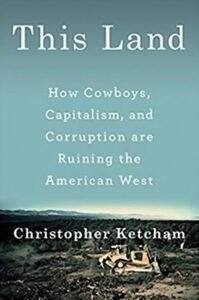 Rotational grazing methods, like the one popular pitchman Alan Savory espouses, require more grazing land already in short supply. Cattle currently trample, desiccate, and pollute soil and waterways with excessive manure, and de-vegetate millions of acres of U.S. public lands. Cattle also displace dwindling populations of wild animals who are killed and pushed aside for domesticated, for-profit animals. An entire division of the U.S. FDA (Food & Drug Administration), called Wildlife Services exists only to kill millions of wild animals every year, at taxpayer expense, for the cattle industry.
Rotational grazing methods, like the one popular pitchman Alan Savory espouses, require more grazing land already in short supply. Cattle currently trample, desiccate, and pollute soil and waterways with excessive manure, and de-vegetate millions of acres of U.S. public lands. Cattle also displace dwindling populations of wild animals who are killed and pushed aside for domesticated, for-profit animals. An entire division of the U.S. FDA (Food & Drug Administration), called Wildlife Services exists only to kill millions of wild animals every year, at taxpayer expense, for the cattle industry.
READ: “This Land: How Cowboys, Capitalism and Corruption Are Ruining the American West” by investigative journalist Christopher Ketchum. National Parks Traveler REVIEW.
The “clean coal” of the cattle industry
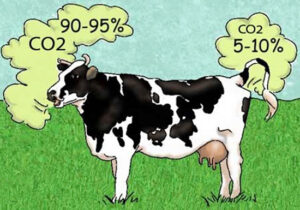 “Regenerative ranching” is how the cattle industry empire is now striking back, in a fight for its survival, deploying multi-million dollar public relations campaigns (like “Milk does a body good.”) as more Americans quit beef and dairy.
“Regenerative ranching” is how the cattle industry empire is now striking back, in a fight for its survival, deploying multi-million dollar public relations campaigns (like “Milk does a body good.”) as more Americans quit beef and dairy.
The beef and dairy industries are desperate to block the tidal wave of new scientific research, or at least muddy the waters, which demonstrates just how destructive methane gas (MH4) from millions of belching, farting cows is to the atmosphere. Methane traps 20-30x more heat than CO2, thus heating the planet catastrophically, more than all the world’s cars, buses, trains, planes and ships combined. READ MORE. So cattle heat the planet, in addition to compacting and desiccating solke, and contaminating waterways with manure run-off.
 Methane and deforestation from farming cattle isn’t magically offset by regenerative agriculture.
Methane and deforestation from farming cattle isn’t magically offset by regenerative agriculture.
by Jessica Scott-Reid | April 22, 2024:
Methane and deforestation from farming cattle isn’t magically offset by regenerative agriculture. The new documentary, “Common Ground” mostly omits this truth.
EXCERPTS:

Common Ground is the new documentary from the filmmakers of Kiss the Ground, the 2020 hit documentary that propelled regenerative agriculture into the mainstream… this followup film is now streaming on Netflix and is playing in over 75 theaters across the U.S. to coincide with Earth Day, on April 22 [2024].
Common Ground ultimately tells the same tale as the first film — that regenerative farming can save the planet — but this time with much more gusto, much more information and seemingly with much more at stake.
The first film was wildly successful. So much so that no matter how many times scientists and science writers demonstrated that regenerative agriculture does not actually “reverse climate change,” the practices were hailed as a solution, endorsed and funded by the U.S.D.A. as “climate-friendly” farming methods.
Unfortunately, that solution is a vastly oversimplified one, and one that omits the importance of people eating less meat to combat climate change.
READ Sentient Media ARTICLE: https://sentientmedia.org/common-ground-cows-climate-change/
 How Big Ag Bankrolled Regenerative Ranching
How Big Ag Bankrolled Regenerative Ranching
by Spencer Roberts | March 5, 2022:
Advocates of “regenerative ranching” methods claim they’re slashing the carbon footprint of the ranching industry — but they’re actually propping up a scam that Big Ag is bankrolling.
EXCERPTS:
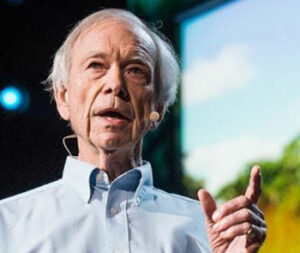
Allan Savory, disseminator of unsubstantiated claims.
Ranching philanthropy [i.e., funding] has also crept into the coffers of charities such as the Nature Conservancy, Audubon Society, and the Union of Concerned Scientists, which published regenerative ranching research with funding from billionaire ranch owners Jeremy Grantham and Tom Steyer. Naturally, Steyer advocated for increased funding of public-private agricultural partnerships to build soil carbon during his run for president.
Most university meat corruption, however, operates beneath the surface. The pipeline from corporate finance to public research is institutionalized through benign-sounding entities like the Foundation for Food and Agricultural Research (FFAR), an agency established in the 2014 US Farm Bill that distributes private research funding to public institutions. To date, FFAR has bankrolled nearly $300 million of research funding from more than five hundred corporations, including McDonald’s, Pepsi, Kroger, JBS, Tyson, Monsanto, Amazon, and General Mills.
Although many prominent academics swear by regenerative ranching in industry-adjacent fields such as Animal Sciences and Rangeland Management, international research bodies resoundingly disagree, with the [United Nations’] Intergovernmental Panel on Climate Change estimating that the world’s agricultural soils can only sequester a few gigatons of carbon per year and the Food Climate Research Network concluding that soil carbon sequestration on cattle farms is “substantially outweighed by the greenhouse gas emissions these grazing animals generate.”
READ Jacobian ARTICLE: https://jacobinmag.com/2022/03/big-agriculture-funding-regenerative-ranching-amp-grazing-soil-carbon
It’s not the how, it’s the cows.
“Regenerative agriculture” is Big Ag’s and Big Dairy’s aggressive public relations pushback. As with Big Tobacco and Big Oil, the goal is simply to muddy the waters and obscure, confuse, and even deny the realities of established atmospheric, environmental and climate science — including the reality that cattle are a major contributor to global warming.
In short, it’s not how cows are grazed that matters as much as the sheer number of cows grazing that adds so much methane (MH4) to the atmosphere, thus accelerating the climate crisis. All the more reason your grandmother was right when she simply told you to, “Eat your vegetables.”
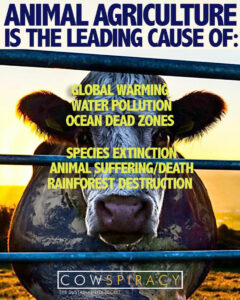 The dairy and beef industries are major drivers of global heating and the climate crisis, and no amount of livestock rotation and public relations spin change this scientific reality. Raising cattle for human consumption, though deeply embedded and romanticized in America’s history and culture is today, one of the most destructive industries on the planet. Simply put, there are too many millions of methane-emitting cows feeding so many billions of humans. Our dairy-milk-and-meat-laden eating habits must change if we want to slow global heating — and save our own fat asses.
The dairy and beef industries are major drivers of global heating and the climate crisis, and no amount of livestock rotation and public relations spin change this scientific reality. Raising cattle for human consumption, though deeply embedded and romanticized in America’s history and culture is today, one of the most destructive industries on the planet. Simply put, there are too many millions of methane-emitting cows feeding so many billions of humans. Our dairy-milk-and-meat-laden eating habits must change if we want to slow global heating — and save our own fat asses.
These methods conveniently and blatantly ignore the elephant in the roomy pasture: methane emissions. According to the E.P.A., cattle operations in the U.S. produce more methane than do the U.S. oil and gas industries, combined. SOURCE: https://www.epa.ie/publications/research/climate-change/Research_Report_288.pdf
Rotational grazing practices — moving cattle around land so they don’t eat all the grass in any one pasture — are not scalable for America’s 95 million cows, require even more land which cattle already occupy too much of. And for a non-essential, luxury product that is a major contributor to global warming.
Up to 4x more effective in reducing carbon emissions — as well reducing methane and ammonia (from manure) emissions — is simply transitioning to a plant-based diet.. That’s a fact the beef and milk industries would prefer you overlook. So-called “free-range” cows require, degrade and pollute up to 10x more land than plant-based crops. Most of America’s 340,000,000 people, feeding off of 95 million U.S. cows which produce so much methane, would benefit from eating less meat anyway.
“Grass-fed beef” is a branding exercise, not a climate solution.

EXCERPTS:
“…regenerative” beef currently represents not so much a scalable climate solution as a way for those who can afford to do so to purchase indulgences for their continued meat consumption. The owners of grass-fed beef ventures may market their premium-priced products as a way out of the hellscape of Western capitalistic agriculture. But absent much broader societal changes, regenerative agriculture’s anti-industrial rhetoric is more of a class marker than a call to revolution.
In 2017, an exhaustive, 127-page study led by scholars at Oxford found that grass-fed livestock “does not offer a significant solution to climate change as only under very specific conditions can they help sequester carbon. This sequestering of carbon is even then small, time-limited, reversible and substantially outweighed by the greenhouse gas emissions these grazing animals generate.”
 READ New Republic ARTICLE:
READ New Republic ARTICLE:
The Myth of Regenerative Ranching
by Jan Dutkiewicz and Gabriel Rosenberg | Sept. 23, 2021
LINK: https://newrepublic.com/article/163735/myth-regenerative-ranching
 Eat More Meat and Save the World: the Latest Implausible Farming Miracle
Eat More Meat and Save the World: the Latest Implausible Farming Miracle
by George Monbiot | Aug 4, 2014:
EXCERPTS:

Allan Savory, disseminator of unsubstantiated claims.
A large number of academic papers have been published in response to his [Allan Savory’s] claims, testing them by means of experimental and comparative studies. The conclusion, overwhelmingly, is that his [Savory’s] statements are not supported by empirical evidence and experimental work, and that in crucial respects his techniques do more harm than good.
A new review of experimental results, in the journal Agricultural Systems, has this to say about Savory’s claims that his Intensive Rotational Grazing (IRG) can regenerate grassland:
“The vast majority of experimental evidence does not support claims of enhanced ecological benefits in IRG compared to other grazing strategies, including the capacity to increase storage of soil organic carbon … IRG has been rigorously evaluated, primarily in the US, by numerous investigators at multiple locations and in a wide range of precipitation zones over a period of several decades. Collectively, these experimental results clearly indicate that IRG does not increase plant or animal production, or improve plant community composition, or benefit soil surface hydrology compared to other grazing strategies
Another review article, in the International Journal of Biodiversity, found that grazing by livestock in arid places is more likely to destroy grass and other vegetation than to protect it:
“Published comparisons of grazed and ungrazed lands in the western US have found that rested sites have larger and more dense grasses, fewer weedy forbs and shrubs, higher biodiversity, higher productivity, less bare ground, and better water infiltration than nearby grazed sites.
As for the claim that holistic management can reverse the build-up of carbon dioxide in the atmosphere, according to RealClimate.org, he’s wrong by orders of magnitude. Just to balance current carbon emissions, the uptake of carbon by all the world’s vegetation (not only grasslands) would have to triple. But Savory says he can go beyond that, and his technique can bring atmospheric carbon “back to pre-industrial levels”. As RealClimate puts it: “science tells us that this claim is simply not reasonable.”
Far from grazing helping to store carbon, holistic management seems to have the opposite effect: the evidence strongly suggests that livestock reduce carbon storage rather than raising it. In terms of total greenhouse gas emissions, the intensive grazing of cattle on grasslands can be even worse than producing them in feedlots.
READ Guardian ARTICLE: https://www.theguardian.com/environment/georgemonbiot/2014/aug/04/eat-more-meat-and-save-the-world-the-latest-implausible-farming-miracle
 The Regenerative Ranching Racket
The Regenerative Ranching Racket
by Spencer Roberts | August 19, 2021:
EXCERPTS:
In recent years, cattle ranching has been championed as everything from a solution to industrial agriculture, soil degradation, and even climate change. But so-called “regenerative ranching” isn’t all it’s cracked up to be.
…emitting greenhouse gases is far from the only damaging environmental side-effect of ranching. In the United States alone, studies have shown that it vectors the spread of invasive plants, endangering endemic flora. It accelerates the erosion of stream banks, clouding waterways and propagating harmful algal and bacterial growth.
It [ranching] desiccates streams, groundwater, and aquifers, diverting them into pastures, stock tanks, and feed crops. It encloses vast expanses of land within fencing, entangling wildlife and inhibiting migration of native grazers like elk, pronghorn, and bison.
It [ranching] entails the trapping, hunting, and poisoning of predators and “pests”, such as prairie dogs, coyotes, and wolves. It promotes the wholesale destruction of ecosystems such as sagebrush and pinyon-juniper forests by methods such as bulldozing, chaining, and even napalm air strikes to create more range land.
It [ranching] produces vast quantities of effluent waste, polluting waterways and washing into river deltas, begetting hypoxic marine dead zones. It incubates zoonoses such as mad cow disease. It expropriates immense quantities of crop yields that could be used more efficiently to feed humans directly.
It occupies an estimated 60% of global agricultural land while providing only 2% of calories consumed worldwide. And although the regenerative ranching movement posits itself as an alternative to the industrial feedlot system associated with many of these repercussions, virtually all grass-fed cattle in the United States spend the final quarter or more of their life in a concentrated animal feeding operation.
The proliferation of industry messaging has been less successful in altering the scientific consensus, but has provided an orchard of alternative narratives, ripe for cherry-picking.
Better management of grass-fed livestock, while worthwhile in and of itself, does not offer a significant solution to climate change as only under very specific conditions can they help sequester carbon. This sequestering of carbon is even then small, time-limited, reversible and substantially outweighed by the greenhouse gas emissions these grazing animals generate.
The godfather of regenerative ranching, however, is a man named Allan Savory. Savory rose to prominence in the United States after a breakout TED talk, a media venture by CNN founder and ranching tycoon Ted Turner. Savory now has a consulting firm, an online school, and a farm certification. The consensus among ecologists—and even many ranching scientists—regards him [Savory] as a crank, but he compares himself to Galileo, claiming that it’s impossible for peers to review his methods of holistic range management. Regardless, his theories are flattering to business and convenient to consumers, which means they still find plenty of advocates in media.
Agribusiness not only funds an increasingly significant proportion of agricultural research in the United States, but a number of state-mandated marketing programs. In 1985, during the Reagan administration’s campaign to fleece federal lands for privatized grazing, congress passed the Beef Promotion and Research Act, placing a small tax on cattle sales to fund industry advertising in public spaces, which has grown over the years with the expansion of the industry.
…ranching industry infiltration into the academy is vast, including on-campus slaughterhouses built with industry funding and parallel institutions such as range ecology and animal sciences, which help to avoid peer scrutiny of industry scientists’ business-related priorities in conventional ecology and zoology departments.
…the ranching industry’s extensive public relations strategies also help to promote ranching pseudoscience in the more progressive corners of popular culture. Ranching has been promoted as a means of combatting climate change in media outlets such as The Nation, The Guardian, Scientific American, and CNN.
The scientific reality is that the concept of sustainable carbon-negative ranching is little more than meat marketing mythology.
READ ARTICLE: https://www.science20.com/spencer_roberts/the_regenerative_ranching_racket-255623
Allan Savory: Myth and Reality
By George Wuerthner, November 12, 2013
EXCERPT:
In short, Savory’s basic theme is a variation on what has been called “short duration grazing” or “mob grazing.” Under such scenarios livestock, typically cattle are tightly herded through a confined pasture (small pastures) or rangeland so that the animals cannot be selective in their choice of food. Then the livestock are moved rapidly on to the next grazing area, and the previously grazed area is rested from livestock for an extended period of time, so the plants can recover and regrow. Savory’s advocacy for monitoring and careful attention to livestock plant utilization is consistent with well-established range management principles.
However, many of his observations about animal behavior, plant ecology, evolutionary history and carbon storage are well outside the accepted scientific consensus. And these ideas can lead to damaged ecosystems and in the case of his ideas about livestock and global warming may actually be counterproductive—leading to greater GHG emissions if implemented according to his ideas.
 READ ARTICLE: http://www.thewildlifenews.com/2013/11/12/allan-savory-myth-and-reality/
READ ARTICLE: http://www.thewildlifenews.com/2013/11/12/allan-savory-myth-and-reality/
The Beef Industry is Destroying the American West and
Worsening the Climate Crisis
By Erika Schelby, September 29, 2023
EXCERPTS:
Currently, the U.S. Bureau of Land Management (BLM) gives out 18,000 permits, allowing some 1.5 million cattle to graze across 155 million acres of federal land—an area equal to the combined size of California and Oregon. In Welfare Ranching: The Subsidized Destruction of the American West, the book’s co-author and ecologist George Wuerthner said that the BLM usually just rubber stamps the permits without carrying out sufficient environmental analysis about allowing grazing.
Ironically, while the American population believes it is funding public lands and national parks to access them and enjoy these landscapes, the taxpayers are generously subsidizing this fee paid by the ranchers, making this “a bad deal financially and environmentally.” On private land in the West, the grazing fee is much higher at around $23.90 a month in 2022.
For ranchers, grazing cattle on public land is indeed a bargain. In 2023, the BLM and the Forest Service grazing fee per animal unit (measured in AUMs: the amount of forage necessary to sustain a cow and her calf per month) was $1.35 per month, which has remained unchanged since 1986. “John Janicek, a Dallas-based attorney who has written about the impacts of the grazing program on climate change,” said that this amount is less than one would pay to feed a goldfish.
Research has shown that livestock grazing and overgrazing are the major causes of desertification, soil carbon loss, lower water holding capacity, loss of species, and eradication of native plants. In addition to this, according to the National Oceanic and Atmospheric Administration (NOAA), heat-trapping methane emissions saw the fourth-largest increase on record in 2022, with human activity like landfill and livestock being sources for the increase in these emissions. Grazing cattle are a major source of emissions in the United States.
READ ARTICLE: https://www.counterpunch.org/2023/09/29/the-beef-industry-is-destroying-the-american-west-and-worsening-the-climate-crisis/
Wildfire & Grazing: More Livestock Will Only Make Things Worse
By Adam Bronstein, Western Watersheds Project’s Oregon/Nevada Director, May 12, 2022
EXCERPTS:
Cut through the propaganda propagated by the livestock industry and you will discover that the fuels problem is actually caused by grazing itself. For nearly one hundred and fifty years, under our system of settler colonialism, domestic livestock have been ravaging our native ecosystems while introducing cheatgrass both directly and indirectly into previously resilient deserts, sagebrush steppes, and grasslands. Livestock destroy biotic soil crusts that act as an impenetrable barrier to cheatgrass and other invasives.
What’s downright crazy is increasing the intensity of that same thing [grazing livestock] that caused the problem and still expecting things to change. It’s difficult for commercial interests to accept that there are no good solutions to the wildfire crisis through business as usual.
READ ARTICLE: https://www.counterpunch.org/2022/05/12/wildfire-and-grazing-in-nevada-more-livestock-will-only-make-things-worse/
Federal grazing program causes extensive damage to public lands, shouldn’t count toward 30×30 goals
By John Horning, WildEarth Guardians, Sept. 30, 2021
EXCERPT:
Currently, non-native livestock grazing is authorized on approximately 250 million acres of public lands administered by the U.S Forest Service and Bureau of Land Management. Private livestock corporations pay just $1.35 per month to graze a cow-calf pair, or five sheep, on these federal public lands. The grazing comes at a tremendous cost to wildlife habitat, threatened and endangered species, and clean water.
Livestock grazing is a threat to biodiversity and a contributor to the climate crisis—it’s an absolute farce for the Biden administration to be including grazed public lands as a contributor to critical 30×30 conservation goals.
READ Press Release: https://wildearthguardians.org/press-releases/federal-grazing-program-causes-extensive-damage-to-public-lands-shouldnt-count-toward-30×30-goals
America has a manure problem, and the miracle solution being touted isn’t all that it seems
By Jenny Splitter, The Guardian
January 20, 2022
EXCERPTS:
Cattle are the highest methane-emitting livestock animal because of the way cows digest food. Unlike most other farmed animals, most of cattle’s methane emissions come from belches, not manure. And those methane emissions, known as enteric methane emissions, are responsible for a large chunk of overall greenhouse gas emissions from the food sector in the US – 25% by EPA figures. But digesters do nothing to address enteric methane.
Tyler Lobdell, an attorney with Food and Water Watch, says his group is particularly concerned that the rise in [methane] digesters only serves to further entrench both natural gas and factory farm production – two industries that are already notoriously difficult to regulate. “We’re marrying these two industries in such a way that it will become very difficult to advocate for change,” he says.
Depending on how they’re used, anaerobic digesters may also not be as effective at curbing air and water pollution as they are on paper. “We already don’t enforce regulations on the books for air and water in CAFOs,” says David Cwiertny, a professor of engineering and environmental policy at the University of Iowa, referring to concentrated animal feeding operations. “I’m hard pressed to believe we’ll do it for digesters.”
Allan Savory’s Holistic Management Theory Falls Short on Science
By Christopher Ketchum, Sierra Magazine
February 23, 2017
EXCERPTS:
Since that initial study was conducted, Savory has faced a new wave of scrutiny. A group of U.S.-based rangeland scientists, led by David Briske, a professor in the Department of Ecosystem Science and Management at Texas A&M University, stated flatly that the Savory method “can not green deserts or reverse climate change.” Savory’s claims “are not only unsupported by scientific information, but they are often in direct conflict with it.” Briske’s study, published in the journal of the Society for Range Management in 2013, concluded: “We find all of Mr. Savory’s major claims to be unfounded.”
The Briske team found that Savory misrepresented the photos of landscapes he presents as evidence of the alleged desertifying effect of removing cattle. One of the photo series he often uses features Chaco Culture National Historical Park in New Mexico. But the land, the Briske report said, was not desertified from lack of cattle. Instead, the landscape was slowly recovering from decades of abusive overgrazing. (I emailed Briske for an interview, but he declined to talk. “Frankly, I have grown weary of the grandiose and unsubstantiated claims of Mr. Savory,” Briske replied.)
Andres Cibils, a professor of range science at New Mexico State University, looked at Savory’s claims of rangeland regeneration in Patagonia, among the highlights of the [Savory] TED Talk. “In the case of Patagonia,” Cibils told me, “there are no credible data to support Savory’s success assertions.”
According to some researchers, Savory appears to misunderstand the intricate processes of soil carbon sequestration and nutrient cycling. I called up Kelsey Brewer, a one-time organic farmer who is now a staff researcher at the University of California, Davis, and who is studying whether livestock grazing alone can improve sequestration. “Carbon is central to his argument,” Brewer said. “But he [Savory] gives no specifics in his TED Talk. And no data. He makes claims, and shows pictures.”
In Savory’s universe, ungrazed land, known as “rested” land, will always wither away. “It’s just wrong,” said Brewer. A substantial number of studies on desert grassland have found that with rest, grass cover “increases dramatically,” while “intensive grazing delays this recovery.”
READ ARTICLE: https://www.sierraclub.org/sierra/2017-2-march-april/feature/allan-savory-says-more-cows-land-will-reverse-climate-change
The Myth of Sustainable Meat
By James McWilliams, The New York Times
April 12, 2012
EXCERPT:
THE industrial production of animal products is nasty business. From mad cow, E. coli and salmonella to soil erosion, manure runoff and pink slime, factory farming is the epitome of a broken food system.
There have been various responses to these horrors, including some recent attempts to improve the industrial system, like the announcement this week that farmers will have to seek prescriptions for sick animals instead of regularly feeding antibiotics to all stock. My personal reaction has been to avoid animal products completely. But most people upset by factory farming have turned instead to meat, dairy and eggs from nonindustrial sources.
Indeed, the last decade has seen an exciting surge in grass-fed, free-range, cage-free and pastured options. These alternatives typically come from small organic farms, which practice more humane methods of production. They appeal to consumers not only because they reject the industrial model, but because they appear to be more in tune with natural processes.
For all the strengths of these alternatives, however, they’re ultimately a poor substitute for industrial production. Although these smaller systems appear to be environmentally sustainable, considerable evidence suggests otherwise.
Grass-grazing cows emit considerably more methane than grain-fed cows. Pastured organic chickens have a 20 percent greater impact on global warming. It requires 2 to 20 acres to raise a cow on grass. If we raised all the cows in the United States on grass (all 100 million of them), cattle would require (using the figure of 10 acres per cow) almost half the country’s land (and this figure excludes space needed for pastured chicken and pigs). A tract of land just larger than France has been carved out of the Brazilian rain forest and turned over to grazing cattle. Nothing about this is sustainable.
READ New York Times OPINION column: https://treespiritproject.com/wp-content/uploads/2023/07/Regenearative-Ranching-MYTH-NY-Times-Opinion-The-Myth-of-Sustainable-Meat-James-McWilliams-4.12.12.pdf
LINK to original New York Times post (may be pay-walled): https://www.nytimes.com/2012/04/13/opinion/the-myth-of-sustainable-meat.html


